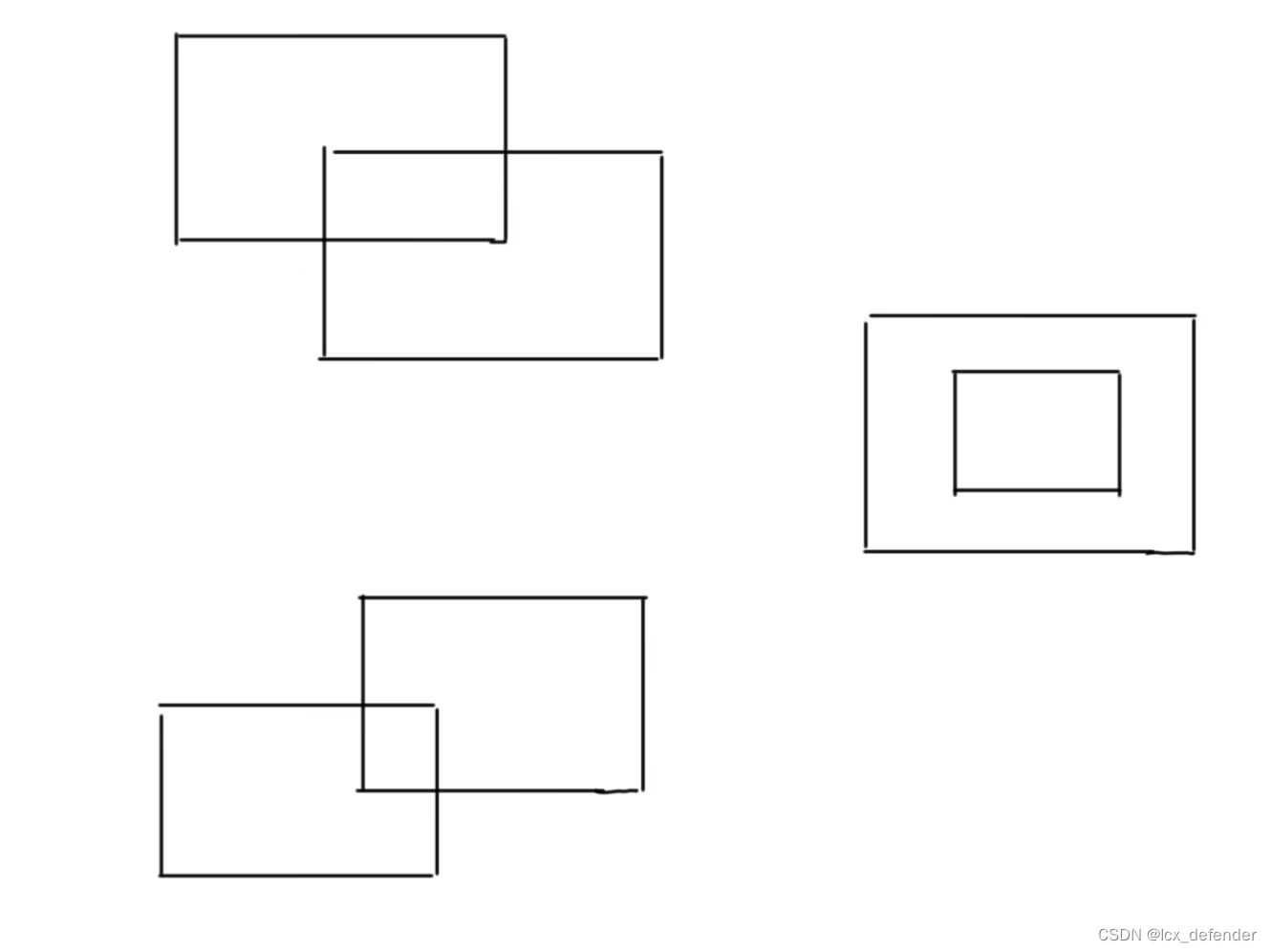【蓝桥备赛】矩形总面积——计算几何
发布时间:2024年01月23日
题目链接
个人思路
根据题意,两个矩形如果存在重叠部分,只会是这三种其一。不过再仔细观察这些边的关系,容易得到以下计算重叠区域大小的方法。

// 其中变量含义见题面
ll width = max(0LL, min(x2, x4) - max(x1, x3));
ll height = max(0LL, min(y2, y4) - max(y1, y3));
那么,这道题的解法就是,计算两个矩形的面积再减去重复部分(如果有重复部分的话)
看完下方的代码,可能有人奇怪为什么没去判断 width 和 height的大小,的确我省去了这一个判断。这是因为,在一个平面内,如果两个矩形有重叠部分的话,计算公式只能是上面那段代码计算方法,不明白可以对照图形来看,而当他们之间的差值为负的,那么就被我的 max 语句定为0了,只要width 和 height的值有一个为0,那么在减去的时候,就会减去的就是0。
if(width > 0 && height > 0)
参考代码
Java
import java.util.Scanner;
// AC
public class Main {
static long x1, y1, x2, y2, x3, y3, x4, y4;
public static void main(String[] args) {
Scanner sc = new Scanner(System.in);
// 左下
x1 = sc.nextLong();
y1 = sc.nextLong();
// 右上
x2 = sc.nextLong();
y2 = sc.nextLong();
// 左下
x3 = sc.nextLong();
y3 = sc.nextLong();
// 右上
x4 = sc.nextLong();
y4 = sc.nextLong();
long res = (x2 - x1) * (y2 - y1) + (x4 - x3) * (y4 - y3);
// 计算重复区域面积
long width = Math.max(0, Math.min(x2, x4) - Math.max(x1, x3));
long height = Math.max(0, Math.min(y2, y4) - Math.max(y1, y3));
res -= width * height;
System.out.println(res);
}
}
C/C++
#include<bits/stdc++.h>
using namespace std;
typedef long long ll;
// AC
int main()
{
ll x1, y1, x2, y2, x3, y3, x4, y4;
cin >> x1 >> y1 >> x2 >> y2 >> x3 >> y3 >> x4 >> y4;
ll res = (x2 - x1) * (y2 - y1) + (x4 -x3) * (y4 - y3);
ll width = max(0LL, min(x2, x4) - max(x1, x3));
ll height = max(0LL, min(y2, y4) - max(y1, y3));
res -= width * height;
cout << res;
return 0;
}
文章来源:https://blog.csdn.net/weixin_44581175/article/details/135785323
本文来自互联网用户投稿,该文观点仅代表作者本人,不代表本站立场。本站仅提供信息存储空间服务,不拥有所有权,不承担相关法律责任。 如若内容造成侵权/违法违规/事实不符,请联系我的编程经验分享网邮箱:chenni525@qq.com进行投诉反馈,一经查实,立即删除!
本文来自互联网用户投稿,该文观点仅代表作者本人,不代表本站立场。本站仅提供信息存储空间服务,不拥有所有权,不承担相关法律责任。 如若内容造成侵权/违法违规/事实不符,请联系我的编程经验分享网邮箱:chenni525@qq.com进行投诉反馈,一经查实,立即删除!
最新文章
- Python教程
- 深入理解 MySQL 中的 HAVING 关键字和聚合函数
- Qt之QChar编码(1)
- MyBatis入门基础篇
- 用Python脚本实现FFmpeg批量转换
- IDEA常用插件(本人常用,不全)
- Qt第二周周二作业
- 【华为OD题库-094】最佳的出牌方法-java
- 动态规划 | 鸡蛋问题 | 元旦假期来点“蛋”题
- 基于机器学习算法的数据分析师薪资预测模型优化研究(文末送书)
- 【C语言】数组
- 票商一键订坐系统电影票票务系统搭建--小程序、JAVA
- 新手也能理解的PyTorch激活函数详解
- 【java面试题】实现equals(Person person)方法的Person存入HashSet无法排重!
- MySQL缓冲池(Buffer Pool)深入解析:原理、组成及其在数据操作中的核心作用